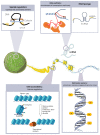Epigenetics and Congenital Heart Diseases
- PMID: 35735814
- PMCID: PMC9225036
- DOI: 10.3390/jcdd9060185
Epigenetics and Congenital Heart Diseases
Abstract
Congenital heart disease (CHD) is a frequent occurrence, with a prevalence rate of almost 1% in the general population. However, the pathophysiology of the anomalous heart development is still unclear in most patients screened. A definitive genetic origin, be it single-point mutation or larger chromosomal disruptions, only explains about 35% of identified cases. The precisely choreographed embryology of the heart relies on timed activation of developmental molecular cascades, spatially and temporally regulated through epigenetic regulation: chromatin conformation, DNA priming through methylation patterns, and spatial accessibility to transcription factors. This multi-level regulatory network is eminently susceptible to outside disruption, resulting in faulty cardiac development. Similarly, the heart is unique in its dynamic development: growth is intrinsically related to mechanical stimulation, and disruption of the intrauterine environment will have a direct impact on fetal embryology. These two converging axes offer new areas of research to characterize the cardiac epigenetic regulation and identify points of fragility in order to counteract its teratogenic consequences.
Keywords: congenital heart disease; epigenetics; genetics.
Conflict of interest statement
The authors declare no conflict of interest.
Figures
Similar articles
-
Epigenetics in Congenital Heart Disease.J Am Heart Assoc. 2022 Apr 5;11(7):e025163. doi: 10.1161/JAHA.121.025163. Epub 2022 Mar 29. J Am Heart Assoc. 2022. PMID: 35348004 Free PMC article. Review.
-
Epigenomics in stress tolerance of plants under the climate change.Mol Biol Rep. 2023 Jul;50(7):6201-6216. doi: 10.1007/s11033-023-08539-6. Epub 2023 Jun 9. Mol Biol Rep. 2023. PMID: 37294468 Review.
-
Exploring the Role of Maternal Nutritional Epigenetics in Congenital Heart Disease.Curr Dev Nutr. 2020 Nov 10;4(11):nzaa166. doi: 10.1093/cdn/nzaa166. eCollection 2020 Nov. Curr Dev Nutr. 2020. PMID: 33294766 Free PMC article. Review.
-
Role of Epigenetics in Cardiac Development and Congenital Diseases.Physiol Rev. 2018 Oct 1;98(4):2453-2475. doi: 10.1152/physrev.00048.2017. Physiol Rev. 2018. PMID: 30156497 Review.
-
The role of DNA methylation in syndromic and non-syndromic congenital heart disease.Clin Epigenetics. 2021 Apr 26;13(1):93. doi: 10.1186/s13148-021-01077-7. Clin Epigenetics. 2021. PMID: 33902696 Free PMC article. Review.
Cited by
-
Epigenetic Evaluation of the TBX20 Gene and Environmental Risk Factors in Mexican Paediatric Patients with Congenital Septal Defects.Cells. 2023 Feb 11;12(4):586. doi: 10.3390/cells12040586. Cells. 2023. PMID: 36831251 Free PMC article.
-
Adenosine deaminase acting on RNA 1 (ADAR1) as crucial regulators in cardiovascular diseases: structures, pathogenesis, and potential therapeutic approach.Front Pharmacol. 2023 Aug 17;14:1194884. doi: 10.3389/fphar.2023.1194884. eCollection 2023. Front Pharmacol. 2023. PMID: 37663249 Free PMC article. Review.
-
Striving Towards Equity in Cardiovascular Genomics Research.Curr Atheroscler Rep. 2025 Feb 18;27(1):34. doi: 10.1007/s11883-025-01277-z. Curr Atheroscler Rep. 2025. PMID: 39964583 Free PMC article. Review.
-
Biological Age in Congenital Heart Disease-Exploring the Ticking Clock.J Cardiovasc Dev Dis. 2023 Dec 10;10(12):492. doi: 10.3390/jcdd10120492. J Cardiovasc Dev Dis. 2023. PMID: 38132660 Free PMC article. Review.
-
Experimental verification and validation of immune biomarkers based on chromatin regulators in ischemic stroke.Front Genet. 2022 Aug 29;13:992847. doi: 10.3389/fgene.2022.992847. eCollection 2022. Front Genet. 2022. PMID: 36105086 Free PMC article.
References
Publication types
LinkOut - more resources
Full Text Sources



